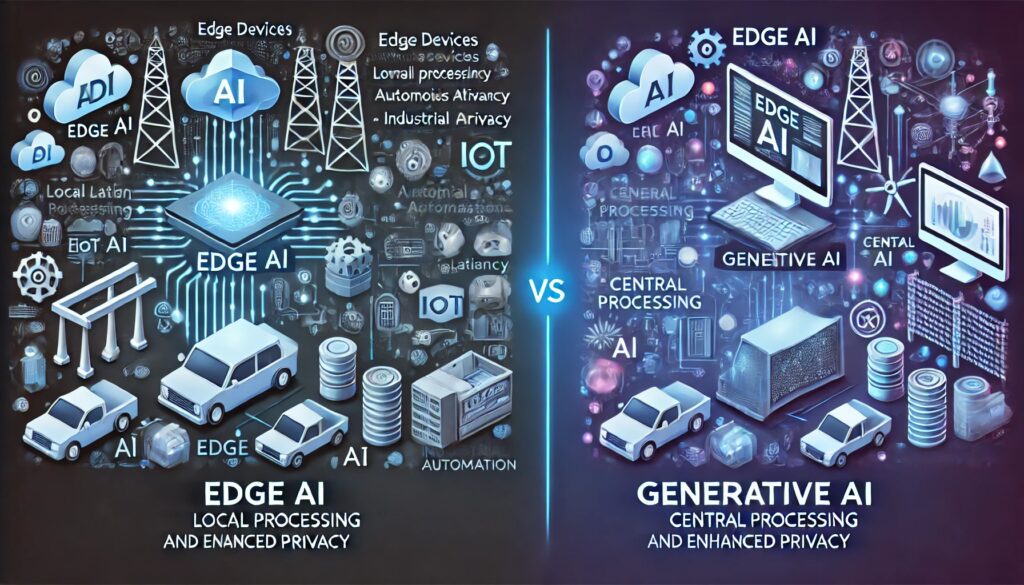
AI Showdown: Edge AI vs. Generative AI
Artificial Intelligence (AI) is reshaping our world in ways we once thought impossible. In the realm of AI, two powerful contenders are making waves: Edge AI and Generative AI. Let’s dive into their unique architectures and deployment strategies.
Edge AI: Lightweight and Local
Architecture: Edge AI models are designed to be lightweight and highly optimized. These models excel in specific tasks, making them perfect for devices with limited computational power. Think microcontrollers, smartphones, and IoT devices. They often use specialized hardware accelerators like GPUs, TPUs, and FPGAs to ensure efficient computation.
Deployment: Edge AI is all about bringing intelligence closer to the data source. By deploying on the network’s edge, these models minimize latency and maximize real-time processing. Imagine cameras with built-in image recognition, autonomous vehicles with onboard AI, or smartwatches that monitor your health in real-time.
Generative AI: Complex and Creative
Architecture: Generative AI involves complex, large-scale models like deep neural networks and transformers. These models need significant computational resources for both training and inference. Examples include GPT-4 for text generation, DALL-E for image creation, and MusicVAE for composing music.
Deployment: Unlike Edge AI, Generative AI thrives in centralized environments with immense computational power. These models are typically deployed in data centers or on cloud platforms like AWS, Google Cloud, and Microsoft Azure, where they can tap into vast processing capabilities.
Performance and Scalability
Edge AI: Optimized for Real-Time Efficiency
Performance: Edge AI models are engineered for low latency and real-time processing. This makes them ideal for applications where immediate responses are crucial. However, these models face performance constraints due to the limited computational and power resources available on edge devices.
Scalability: The scalability of Edge AI comes from its ability to distribute models across numerous devices. Each device operates independently, which enhances the system’s robustness and fault tolerance. This decentralized approach means that even if one device fails, the rest continue to function effectively.
Generative AI: Powering Creativity with Computation
Performance: Generative AI, on the other hand, has a high computational demand, particularly during the training phase. It requires powerful hardware, such as GPUs or TPUs, to manage the complexity of its models. These models are resource-intensive, making them less suited for real-time applications compared to Edge AI.
Scalability: Generative AI scales by utilizing distributed computing clusters and parallel processing. This often involves leveraging cloud infrastructure, which allows for flexible scaling of resources as needed. By distributing the computational load, Generative AI can handle extensive datasets and complex model architectures efficiently.
Data Handling and Privacy
Edge AI: Local and Secure Processing
Data Handling: Edge AI excels in processing data locally, significantly reducing the need to transfer data to central servers. This local processing is particularly beneficial for applications dealing with sensitive data, as it enhances data privacy and security.
Privacy: Since data is processed at the source, Edge AI offers higher privacy protection. This local processing minimizes the risk of data breaches and unauthorized access. By not transmitting data over networks, Edge AI ensures that sensitive information remains secure and private.
Generative AI: Centralized and Resource-Intensive
Data Handling: Generative AI requires large datasets for training, often necessitating data transfer and storage in centralized locations. While inference can sometimes be performed locally, the training phase is typically centralized due to the extensive computational resources required.
Privacy: The reliance on large datasets brings potential privacy concerns, especially when the data includes sensitive information. To mitigate these concerns, techniques such as anonymization, differential privacy, and federated learning are employed. These strategies help in protecting individual privacy while allowing the model to learn from vast amounts of data.
In both cases, effective data handling and robust privacy measures are crucial for the success and acceptance of AI technologies in sensitive applications.
Applications and Use Cases
Edge AI: Versatile and Immediate
Applications:
- Autonomous Driving: Real-time object detection and navigation are crucial for the safety and efficiency of self-driving cars.
- Industrial Automation: Predictive maintenance and quality control in manufacturing processes help reduce downtime and improve product quality.
- Health Monitoring: Wearable devices track vital signs, providing continuous health monitoring and early detection of potential issues.
- Smart Home: Voice assistants and security cameras with AI capabilities enhance convenience and security in home environments.
Use Cases:
- Retail: Edge AI analyzes customer behavior and manages inventory, optimizing stock levels and improving customer satisfaction.
- Agriculture: Drones equipped with Edge AI monitor crops and detect pests, enabling precise and timely interventions.
- Energy: Smart grids use Edge AI for energy consumption optimization, ensuring efficient and reliable power distribution.
Generative AI: Creative and Analytical Powerhouse
Applications:
- Content Creation: Generative AI produces text, images, and music, pushing the boundaries of creative expression.
- Game Design: AI generates game levels, characters, and narratives, offering unique and dynamic gaming experiences.
- Research: In fields like drug discovery and material design, AI accelerates the discovery of new compounds and materials.
- Customer Service: Automated responses and chatbots improve customer interactions and service efficiency.
Use Cases:
- Marketing: Personalized ad creation and content generation enhance marketing strategies, targeting specific audience segments effectively.
- Education: Automated tutoring systems and content generation for courses support personalized learning experiences.
- Entertainment: AI aids in scriptwriting, music composition, and creating virtual environments, expanding the horizons of the entertainment industry.
Both Edge AI and Generative AI showcase their unique strengths across diverse applications, driving innovation and efficiency in various fields.
Challenges and Limitations
Edge AI: Navigating Constraints
Challenges:
- Limited Computational Resources: Edge AI must operate with minimal computational power, requiring highly optimized models. This can be particularly challenging for complex applications.
- Power Constraints: Many edge devices, such as wearables and IoT sensors, rely on batteries. These devices need to balance performance with power efficiency to ensure long operational life.
- Deployment and Maintenance: Managing and updating a large number of edge devices can be daunting. Ensuring consistent performance across various environments adds to the complexity.
Limitations:
- Hardware Constraints: The capabilities of Edge AI are often limited by hardware. This can restrict the complexity and scale of the tasks it can perform.
- Complex Task Handling: While efficient, Edge AI may struggle with very complex tasks that demand significant computational resources. It is best suited for specific, well-defined applications.
Generative AI: Balancing Power and Ethics
Challenges:
- High Computational Cost: Training large Generative AI models requires extensive computational resources. This can be expensive and time-consuming, limiting accessibility for smaller organizations.
- Quality and Coherence: Ensuring that the generated content is of high quality and coherent is a significant challenge. Poorly generated outputs can undermine the effectiveness of AI applications.
- Ethical and Legal Concerns: The use of Generative AI raises numerous ethical and legal questions, especially concerning the authenticity and ownership of the content produced.
Limitations:
- Data Dependency: Generative AI models rely heavily on vast amounts of data to function effectively. Acquiring and managing this data can be challenging.
- Bias and Inappropriate Content: There is a risk of generating biased or inappropriate content if the training data contains such biases. This can lead to ethical issues and undermine trust in AI systems.
- Misuse Potential: Generative AI can be misused to create deepfakes or other malicious content, posing significant risks to privacy and security.
Understanding these challenges and limitations is crucial for effectively leveraging both Edge AI and Generative AI in various applications. While they offer immense potential, addressing these issues is key to unlocking their full capabilities.
Future Trends
Edge AI: On the Cutting Edge
Trends:
- Improved Hardware Accelerators: Advancements in hardware accelerators for edge devices are enhancing their capabilities. These improvements allow for more efficient processing and better performance.
- Federated Learning: This technique helps to enhance model accuracy without the need to centralize data. By training models locally on edge devices, privacy is preserved, and data security is improved.
- Integration with 5G Networks: The integration of 5G technology provides better connectivity and lower latency. This is crucial for applications that require real-time data processing and communication.
Research Directions:
- Developing Efficient AI Models: Researchers are focused on creating more efficient and compact AI models that can operate within the constraints of edge devices.
- Enhancing Security: Security features are being enhanced to protect edge AI deployments from potential threats and breaches.
- Expanding Applications: There is significant interest in expanding the use of Edge AI in smart cities and industrial IoT. These applications leverage the benefits of localized processing and real-time data handling.
Generative AI: Shaping the Future of Creativity
Trends:
- Larger and More Capable Models: The development of even larger and more capable generative models continues, pushing the boundaries of what AI can create.
- Improved Content Control: Techniques for controlling and fine-tuning the content generated by AI are improving, allowing for more precise and tailored outputs.
- Creative Industries: The use of Generative AI in creative industries is increasing. From art and music to writing and game design, AI is becoming a valuable tool for creators.
Research Directions:
- Ethical and Bias Issues: Addressing ethical and bias issues in generated content is a major focus. Ensuring that AI outputs are fair and unbiased is crucial for broader acceptance.
- Model Interpretability: Enhancing the interpretability and explainability of generative models is important for gaining trust and understanding of AI processes.
- New Domains: Researchers are exploring new domains for generative applications, such as scientific research and complex simulations. These areas can benefit greatly from AI’s ability to generate and analyze vast amounts of data.
By examining these trends and research directions, it’s clear that Edge AI and Generative AI each have unique strengths and challenges. Edge AI excels in real-time, localized processing, making it ideal for applications that require immediate data handling and decision-making. Generative AI, with its capacity to create new and diverse content, leverages large-scale data and computational power to push the boundaries of creativity and innovation. As these technologies evolve, they will continue to transform various industries and applications, driving forward the future of AI.
Resources on Edge AI & Generative AI
Edge AI Resources:
- Edge AI: The Next Wave in AI
- This article explores the rise of Edge AI, its architecture, deployment, and real-world applications, including autonomous vehicles and smart cities.
- Read more on Forbes
- The Promise of Edge AI: What’s Next in AI
- Delve into the benefits and challenges of Edge AI, including data privacy, latency reduction, and real-time processing capabilities.
- Read more on TechCrunch
- Edge AI: Bringing the Power of AI to the Edge
- A comprehensive look at how Edge AI is transforming industries, from healthcare to manufacturing, by processing data locally on edge devices.
- Read more on NVIDIA Blog
Generative AI Resources:
- Understanding Generative AI: Creating Beyond Imagination
- This article provides an overview of Generative AI, its underlying technologies like GANs and transformers, and its applications in content creation.
- Read more on MIT Technology Review
- The Impact of Generative AI on Creativity and Work
- Explore how Generative AI is reshaping creative industries, from art and music to advertising and game design, and its implications for the future of work.
- Read more on Wired
- Generative AI: Revolutionizing Content Creation and Beyond
- An in-depth look at how Generative AI models like GPT-4 and DALL-E are pushing the boundaries of what AI can create, including text, images, and more.
- Read more on OpenAI Blog
Comprehensive Resources on Both Edge AI and Generative AI:
- Edge AI vs. Generative AI: Understanding the Differences and Applications
- This article compares Edge AI and Generative AI, highlighting their unique strengths, challenges, and use cases across various industries.
- Read more on Towards Data Science
- How Edge AI and Generative AI are Shaping the Future of Technology
- A detailed exploration of how both Edge AI and Generative AI are driving innovation in technology, from real-time processing to creative content generation.
- Read more on VentureBeat





